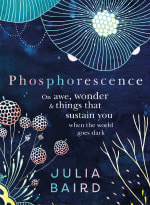 Journalist and writer Julia Baird mixes self-help with memoir in this attractive and very readable guide to life. Phosphorescence aims to make us appreciate what we have in life and offers strategies to cope with grief, disappointment and tragedy. The book opens with a piece on one of Julia Baird’s favourite hobbies, swimming in the ocean and looking with awe and wonder on the varieties of marine life. This opening sets the scene for a series of essays that discusses subjects such as silence, nature, self-worth, friendship and resilience. A lot of the early pieces in Phosphorescence mix commentary with scientific research and, while pleasant to read, can be a bit uninspired. The book, however, gains strength as it goes along and by the end, when Baird writes very personally about issues of faith and acceptance, it's hard not to be moved by her honesty and vulnerability. I came away quite humbled by Phosphorescence. In many of the book’s pieces Baird discusses the hard times she’s endured, notably multiple surgeries for a recurring cancer, and what has got her through, how illness has changed her perspective and helped to prioritise what’s important. For anyone who grumbles about life and needs a reality check, Phosphorescence is a gentle reminder of how fragile and amazing life is. Phosphorescence: On Awe, Wonder, and the Things That Sustain You When the World Goes Dark, by Julia Baird. Published by 4th Estate. $32.99 Review by Chris Saliba 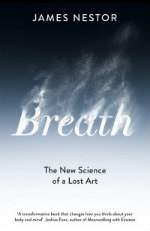 A surprising journey into the mouth and nasal passages. Science writer James Nestor has long suffered breathing related health problems. To try and sort out what was wrong with him, he took a decade long investigation into all things to do with breathing, focusing on the mouth, nasal passages and inhaling and exhaling techniques. Volunteering as a guinea pig in a series of scientific experiments, Nestor found some astonishing results. The main takeaway from the book is that we need to breathe in a more controlled manner (5.5 seconds in, 5.5 seconds out is optimal) and through our noses. Our nasal passages filter and pressurise air, which has a beneficial effect, helping to us overcome allergies and congestion. Nose breathing also helps fight bacteria. Too much mouth breathing, especially during sleep, results in snoring and sleep apnea. One of the more fascinating results of Nestor’s research is the development of our mouths. The advent of agriculture has resulted in softer, more processed foods, and as a result, less chewing. Mouth sizes have actually gotten smaller since our hunter-gatherer forbears, resulting in breathing problems. After a year of having endured a mouth brace that forced his jaw to work more, x-ray imaging found Nestor’s air passages had opened more and he’d developed extra bone density on his face. All a result of extra chewing. This is a fascinating work of science, offering many surprises as to how the respiratory system works. Highly recommended, especially for those with breathing difficulties and ailments. Breath: The New Science of a Lost Art. Published by Penguin Life. $35 Review by Chris Saliba 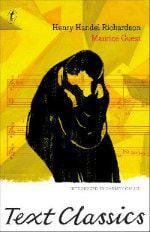 Against the lush backdrop of 1890s Leipzig, two unhappy lovers destroy each other in spectacular fashion. An emotional train wreck that you can't look away from. Maurice Guest, an aspiring pianist and dissatisfied teacher, leaves his job in England to study music in Leipzig, Germany. It's the 1890s, and Leipzig is a cultural centre, with ambitious students, musicians and artists swirling around its vibrant conservatoriums and teeming streets. In the midst of this heady environment, bursting with dynamic personalities and outsize egos, Maurice catches a glimpse of Louise Dufrayer, an Australian woman several years his senior. She is not your classic beauty, but nonetheless he becomes obsessed with her. His friend, Madeleine Wade, a struggling student with a practical outlook, knows Louise's backstory and warns him to keep a wide berth. Louise has been carrying on an affair with the brilliant violinist, Schilsky. Schilsky is a complete cad, utterly immoral, and when he dumps Louise and bolts, Maurice begs her to allow him to pick up the pieces. The two enter into a relationship which is doomed from the start. Louise, with her refined taste in men and music, suffers in a state of perpetual dissatisfaction. Maurice has his faults too, chiefly an obsessive nature divorced from reality. The two lovers try in their own way to make a go of things, but a sea of personal grievances and dire secrets bubble away underneath, constantly threatening to blow everything up. Maurice Guest was Australian novelist Henry Handel Richardson's first novel, published in 1908. Perhaps its most striking aspect is its modernity. Her frank detailing of the sex lives of Leipzig's cultural elite – the bed hopping, exploitation, sadism and other shennanigans – reads like Freudian case studies. Take away the nineteenth century frocks and furniture and the story could easily take place today. Richardson is a master psychologist and she expertly plays her wide cast of complex characters, elucidating in addictive prose the many troubling layers that make up the human condition. That this drama is sustained so wonderfully for over 600 pages, its interest never flagging, is a testament to Richardson's great powers as a novelist. With its strong hints of Madame Bovary and Anna Karenina, Maurice Guest is first class stuff. Surely one of the best novels written by an Australian. Maurice Guest, by Henry Handel Richardson. Published by Text. $12.95 Review by Chris Saliba 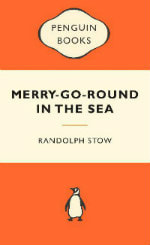 Randolph Stow's surreal, nostalgic backward glance at childhood during war. Merry-Go-Round in the Sea opens in 1941. Six-year-old Rob Coram lives in Geraldton, Western Australia, and spends his young days in the company of his aunts, cousins and other family members. It's quite an idyllic life, one at a far remove from all the political trouble brewing in Europe. Rob especially looks up to his older cousin, Rick, who enlists to go to war. As the years progress, and the Second World War is fought with greater ferocity, Rob's extended family moves further away from the city and townships, finally to Andarra. When the war ends, Rob looks forward to seeing his cousin Rick again. He expects that life will simply pick up from where it has left off. But the centre of gravity has radically changed. Rick was held as a prisoner of war and saw things he cannot forget. He's a changed man and Rob's idealised cousin is now hollowed out, a broken man who can barely take an interest in his own life. Rob sees him disappearing before his very own eyes. Australian poet and novelist Randolph Stow first published this now acclaimed classic in 1965. It's an incredibly moody, evocative portrait of Australia during the war years. While the novel's poetic style has a timeless quality, it also contains contemporary descriptions of First Australians and outdated attitudes towards women. The book is not in itself sexist or racist, yet faithfully records conversations that were. Stow highlights the irony of Australia's racism: "It was funny about black ******. They were Australian. They were more Australian than Rob was, and he was fifth generation. And yet somehow they were not Australian." There's not much plot to go by in all of this, simply page after page of dreamy, hazy descriptions and bland yet strangely surreal conversations between family members. The whole story – all four hundred pages of it – passes like a beautiful, disturbing dream. Stow's skill is such that it is all seamlessly woven together; it doesn't feel so much like a novel, more an hallucinatory experience. An Australian classic not to be overlooked. Merry-Go-Round in the Sea, by Randolph Stow. Published by Penguin. $12.99 Review by Chris Saliba 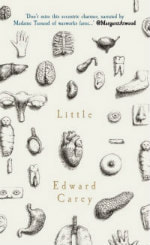 English novelist Edward Carey re-imagines the life of Madame Tussaud. Written as an autobiography, but reading like a novel, Edward Carey's Little is narrated by Marie Grosholtz, later known to the world as Madame Tussaud. Born in 1761, little Marie finds herself moved to Bern, in Switzerland, at the age of six. Fatherless, she soon loses her mother also. Marie works as a housekeeper for Doctor Curtius, an eccentric man who makes wax replicas of body organs used as public health warnings. On her first night at Doctor Curtius', she sleeps in an eerie room full of lifelike wax lungs, livers and other gruesome body parts. Marie finds an interest in this peculiar art form, learns how to cast wax figures and takes an energetic interest in drawing from life (the novel features illustrations by Carey.) When Curtius later moves to Paris, little Marie follows. They move in with the cruel Widow Picot, wife of a tailor (she keeps a tailor's dummy with her deceased husband's exact proportions prominently in the house, as a macabre memorial) and her sensitive, weakling son, Edmond. Little Marie and Curtius start up a cabinet of wax figures, featuring the famous and the infamous (murderers and criminals, which thrills the population's ghoulish imagination.) Marie's skill at creating wax heads captures the eye of the brother of the king, and she is invited to live at Versailles. This ten year sojourn ends unhappily when it is discovered that Marie has made wax likenesses – none too flattering, mind you – of the royal family. Marie returns to civilian life and continues to cast famous wax heads until the Revolution comes, followed by the terror. Life is enormously precarious post Revolution France, but Marie manages to survive. The novel ends with her moving to France, aged forty-two. There is much to enjoy in this absorbing, historical-fantasy. Ghoulish and Gothic, Little reads for the most part like Dickens, in style and substance (think Little Dorrit.) That's not to say it's a Dickens pastiche, but the influence reverberates pleasantly. The chief charm of the book is how Carey balances fact and fiction. For example the middle section, where Marie lives at Versailles, is spoken of in Madame Tussaud's actual memoirs, although there is no contemporary evidence for this. Carey runs with it, creating a delightfully extravagant narrative of supercilious and eccentric royalty, living in an isolated bubble, a bubble that will later burst quite violently. A steady stream of historical figures throng Little, from royalty and revolutionaries, to thinkers and radicals. It's the sort of book that will have you reaching for Wikipedia and wanting to read further about the French Revolution. It's hard to say thematically what Little is about. Carey clearly enjoys the subject matter – a young woman making wax heads in revolutionary France – and perhaps finds solace in dolls and replicas, preferring them to humans. Marie confesses herself to be somewhat of an oddball. When she miscarries her first child, she feels it typical of someone like her, not able to bring forth a living child, only one that is lifelike. But if she is an oddball and freak, calmly making wax casts of gruesomely decapitated heads, she is also triumphant, coming to accept herself and her peculiar talent. A final chapter, an afterward of three pages, is written by Madame Tussaud at age eighty-nine, telling the reader that she will never go away. An odd book about an outsider whose knack for creating lifelike wax figures is perfectly at home in our own image obsessed society. Little, by Edward Carey. Published by Gallic Books. $29.99 Review by Chris Saliba 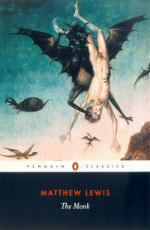 The classic Gothic novel, The Monk, was written by Matthew G. Lewis ( 1775 – 1818) when the author was in his teens. It tells the story of a respected church leader who loses all self control and is tempted by Lucifer. Ambrosio is a monk noted for his piety and stirring sermons. His close companion at the monastery is a young novice named Rosario. He, too, is renowned for his piety and gentle manner. It is soon revealed, however, that Rosario, who always obscures his face under a cowl, is actually a woman named Matilda. She attempts to seduce Ambrosio, but fails. When told she must leave the monastery, she requests being permitted to take a rose bush as a memento. As Ambrosio's hand reaches to pull out the rose bush as a gift, a deadly snake bites him and leaves him hovering between life and death. As Ambrosio languishes on his sickbed, Matilda secretly intervenes while he lies unconscious and sucks the poison from his wound. As Ambrosio revives, Matilda falls sick, having consumed the snake's deadly poison. On her deathbed, about to expire, she manages to finally seduce Ambrosio. He unleashes all his ferocious passions, while Matilda is in the process of dying. Matilda is doomed, or is she? She reveals a secret to Ambrosio: life can mysteriously be restored. She wanders into a cemetery and calls upon Lucifer. The two make a pact and Matilda is saved. But soon Ambrosio, unable to check his desires, is tempted into a world of illicit pleasures superbly organised by the adroit Matilda. The Monk is a stunning piece of decadence, littered with bold images, lurid scenarios and red hot temptation. The book excels at both titillating and shocking with it presentation of sexual lust - and its high price. Lewis's story also shows how the church's sexual repression can unleash terrible monsters. The overzealous nuns, who take in a young woman who has got herself pregnant out of wedlock, treat her with astonishing cruelty. In many instances it's hard to tell whether Matthew Lewis's aim is to moralise or excite. His muscular prose creates fabulous images. The first appearance of Lucifer is extraordinary: “He was perfectly naked: A bright Star sparkled upon his forehead; Two crimson wings extended themselves from his shoulders; and his silken locks were confined by a band of many-coloured fires, which played round his head, formed themselves into a variety of figures, and shone with a brilliance far surpassing that of precious Stones.” The Marquis de Sade declared himself a fan of The Monk. Its resonant mix of psychology, sex, desire and religion make it a story that sticks deep in the mind and soul. The horror ending, where Lucifer makes his reappearance, is truly frightening. The Monk, by Matthew Lewis. Published by Penguin. $19.99 Review by Chris Saliba |
AuthorNorth Melbourne Books Categories
All
Archives
April 2024
|
 RSS Feed
RSS Feed
